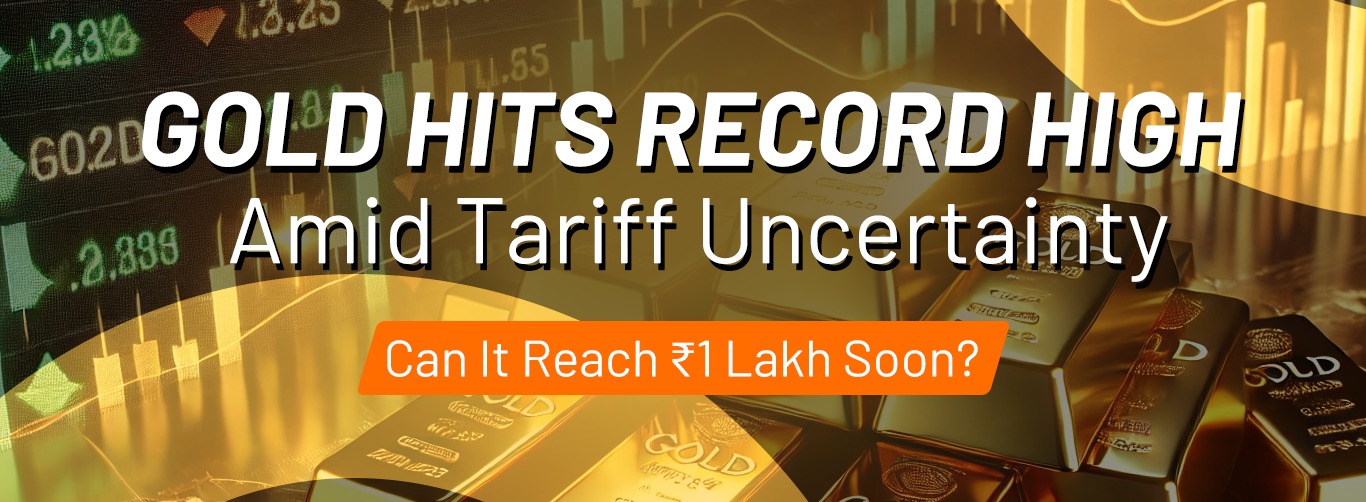Gold prices have surged to record highs, driven by economic uncertainty and geopolitical risks, raising speculation about whether the precious metal can touch the ₹1,00,000 per 10 grams milestone in the near future. The latest rally in gold prices has been fueled by growing concerns over global trade policies, particularly the tariff measures announced by the United States, as well as the impact of central bank decisions and inflationary pressures.
Gold Surges to Record Highs!
In the domestic market, gold futures on the Multi Commodity Exchange (MCX) touched an all-time high of ₹88,672 per 10 grams on March 18. By the afternoon session, the metal was trading 0.65% higher at ₹88,595 per 10 grams. Meanwhile, in international markets, gold prices reached an unprecedented $3,037.60 per ounce, marking a strong uptrend as investors sought safe-haven assets amid escalating economic and geopolitical tensions.
Experts believe the current bullish trend in gold is primarily driven by the uncertainty surrounding the U.S. administration’s tariff policies, which have led to a decline in investor confidence. Concerns over a potential economic slowdown have prompted investors to hedge their risks by increasing their exposure to gold, historically regarded as a reliable store of value during times of financial instability.
Key Drivers Behind Gold’s Rally
Several factors have contributed to the recent surge in gold prices:
1. Trade War and Economic Uncertainty
The U.S. government’s new tariff measures on various imports, including metals and electronics, have heightened fears of a prolonged trade war. Such measures often lead to economic slowdowns, prompting investors to flock to gold as a hedge against market volatility.
2. Central Bank Buying
Major central banks across the globe have been accumulating gold reserves as part of their diversification strategy. Central bank purchases have provided significant support to gold prices, reinforcing investor confidence in the long-term value of the metal.
3. Dollar Index Decline
Gold is priced in U.S. dollars, and any decline in the dollar index makes it more affordable for investors holding other currencies. The dollar index has weakened in recent weeks, further boosting gold’s appeal.
4. Geopolitical Risks
Rising tensions in the Middle East, coupled with global economic instability, have added to gold’s safe-haven appeal. Investors often turn to gold during times of geopolitical crises as a means of protecting their wealth.
5. U.S. Federal Reserve Policy
The Federal Open Market Committee (FOMC) is expected to keep interest rates unchanged in its upcoming meeting. While higher interest rates tend to weigh on gold prices by making fixed-income investments more attractive, a potential rate cut later in the year could provide further upside for gold.
Can Gold Reach ₹1 Lakh?
With gold trading at record highs, the possibility of it reaching ₹1,00,000 per 10 grams has become a widely discussed topic. However, experts believe that while gold is on a strong upward trajectory, reaching this milestone in the immediate future is unlikely.
According to market analysts, for gold to cross ₹1,00,000 per 10 grams, global prices would need to climb to around $3,300 per ounce, coupled with a weaker Indian rupee against the U.S. dollar. Current projections suggest gold could reach $3,100 per ounce in the near term, which translates to approximately ₹91,500-92,000 per 10 grams in the Indian market.
While achieving ₹1,00,000 per 10 grams this year may be difficult, analysts suggest that gold could potentially reach this level within the next two to three years if current growth trends continue. Over the past decade, gold has delivered a compound annual growth rate (CAGR) of around 10%, indicating a steady long-term uptrend.
Conclusion
Gold’s record-breaking rally has reaffirmed its status as a safe-haven asset in times of uncertainty. While reaching ₹1,00,000 per 10 grams in the immediate future may be challenging, the long-term outlook for gold remains highly optimistic. Investors should closely monitor global economic developments, central bank policies, and geopolitical risks to make informed decisions about their gold investments.
Disclaimer: This article is for informational purposes only and should not be considered as investment advice.

Leave a Reply